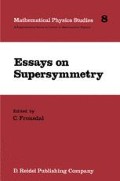Abstract
Attention is called to an interesting property of the space of one-particle states in some especially important massless field theories: the appearance of a one-particle ghost with zero energy. It appears in conformal as well as de Sitter electrodynamics, in the physical sectors of the field mode representations of the respective symmetry groups. It appears again in super de Sitter electrodynamics based on the superalgebra osp(4/l) and in super conformal electrodynamics based on su(2,2/l). We next construct two families of extended super QED, incorporating this property, based on osp(4/N) and on su(2,2/N). There is precisely one osp(4/N) theory and one su(2,2/N) theory of this type for each value of N. The osp(4/6) theory is the same as N = 6 extended supergravity, this is the only one among this family of osp(4/N) theories in which the highest spin is 2. All the one particle states are massless, and in the osp(4/N) theories they can be interpreted as states of two colored singletons. We also critically examine the concept of the Witten index in flat space as well as in de Sitter supersymmetric field theories.
Access this chapter
Tax calculation will be finalised at checkout
Purchases are for personal use only
Preview
Unable to display preview. Download preview PDF.
References
A. D. Sakharov, Dokl. Acad. Nauk SSSR 177, 70 (1967); S. T. Adler, Rev. Mod. Phys. 54, 729 (1982).
H. Terazawa, Phys. Rev. D 22, 184 (1980); and Refs. 6 and 7.
N. T. Evans, J. Math. Phys. 8, 170 (1967); C. Fronsdal, Rev. Mod. Phys. 37, 221 (1965).
C. Fronsdal, Phys. Rev. D12, 3819 (1975).
P. A. M. Dirac, J. Math. Phys. 4, 901 (1963).
M. Flato and C. Fronsdal, Lett. Math. Phys. 2, 421 (1978).
M. Flato and C. Fronsdal, Phys. Lett. 97B. 236 (1980).
G. Mack, Comm. Math. Phys. 55, 1 (1977).
G. Mack and I. Todorov, J. Math. Phys. 10, 2078 (1969).
B. Binegar, C. Fronsdal, and W. Heidenreich, J. Math. Phys. 24, 2828 (1983).
G. Rideau, J. Math. Phys. 19, 1627 (1978).
H. Araki, Comm. Math. Phys. 97, 149 (1985).
B. Binegar, C. Fronsdal and W. Heidenreich, Ann. Phys. 149, 254 (1982).
E. Angelopoulos, M. Flato, C. Fronsdal, and D. Sternheimer, Phys. Rev. D23, 1278 (1981).
I. N. Bernshtein, I. M. Gel’fand and S. I. Gel’fand, Funct. Anal. Priozen 5, 1 (1971) [Func. Anal. Appl. 5, 1 (1971)]; G. Pinczon and J. Simon, Rep. Math. Phys. 16, 49 (1979).
D. Vogan, “Representations of Real Reductive Lie Groups,” Birkhaüser, Boston-Basel-Stuttgart (1981).
G. Zuckerman, Ann. Math . 106, 295 (1977).
B. Binegar, “On the Unitarity of Conformal Supergravity,” UCLA/84/TEP/6 preprint, June 1984.
M. Kaku, P. K. Townsend and P. van Nieuwenhuizen, Phys. Lett. 69B, 304 (1977).
C. Fronsdal, Phys. Rev. D30, 208 (1984).
H. Nicolai and E. Sezgin, Nucl. Phys. B242. 69 (1984); L. Castell, W. Heidenreich and T. Künemund, “All Unitary Positive UIRs of osp(N,4),” Starnberg preprint 1984.
G. Rideau, Rep. Math. Phys. 16, 251 (1979).
R. Akhoury and A. Comtet, Nucl. Phys. B246, 253 (1984).
E. Witten, Nucl. Phys: B202. 153 (1982).
J. Fang and C. Fronsdal, Phys. Rev. D22, 1361 (1980).
Ref. 13, Appendix.
J.-P. Gazeau, “Gauge Fixing and Gupta-Bleuler Triplets in de Sitter QED,” UCLA/84/TEP/8, July 1984, to appear in J. Math. Phys.
P. A. M. Dirac, Ann. Math. 37, 429 (1936).
J. Wess and B. Zumino, Nucl. Phys. B70, 39 (1974).
B. W. Keck, J. Phys. A8, 1819 (1975).
C. Fronsdal, Lett. Math. Phys. 1 165 (1976).
B. Zumino, Nucl. Phys . B127. 189 (1977).
C. Fronsdal and T. Hirai, “Unitary Representations of Supergroups,” UCLA preprint, April 1985, in this volume.
P. Breitenlohner and D. Z. Freedman, Ann. Phys. 144, 249 (1982).
D. Z. Freedman and H. Nicolai, Nucl. Phys. B237, 342 (1984).
S. Ferrara, J. Wess and B. Zumino, Phys. Lett. B51_, 239 (1974).
N. Bourbaki, “Groupes et Algebres de Lie” (Hermann, Paris 1975) Chapters 4–8.
V. Bargmann, Comm. Pure Appl. Math. 14, 187 (1961), and ibid. 20, 1 (1967).
C. Fronsdal, Phys. Rev. D26, 1988 (1982).
M. Günaydin and C. Saclioglu, Phys. Lett. 108B, 169 (1982); M. Günaydin, in “Group Theoretical Methods in Physics,” Istanbul, 1982 (Lecture Notes in Physics 180, Springer-Verlag).
H. Nicolai, “Representations of Supersymmetry in Anti-de Sitter Space,” CERN TH. 3882, April 1984.
M. Flato and C. Fronsdal, Lett. Math. Phys. 8, 159 (1984).
B. Binegar, “Conformal Superalgebras, Massless Representations and Hidden Symmetries,” UCLA/85/TEP/16 preprint, June 1985.
Editor information
Editors and Affiliations
Rights and permissions
Copyright information
© 1986 D. Reidel Publishing Company
About this chapter
Cite this chapter
Flato, M., Fronsdal, C. (1986). Spontaneously Generated Field Theories, Zero-Center Modules, Colored Singletons and the Virtues of N = 6 Supergravity. In: Fronsdal, C. (eds) Essays on Supersymmetry. Mathematical Physics Studies, vol 8. Springer, Dordrecht. https://doi.org/10.1007/978-94-009-4624-8_4
Download citation
DOI: https://doi.org/10.1007/978-94-009-4624-8_4
Publisher Name: Springer, Dordrecht
Print ISBN: 978-94-010-8555-7
Online ISBN: 978-94-009-4624-8
eBook Packages: Springer Book Archive

